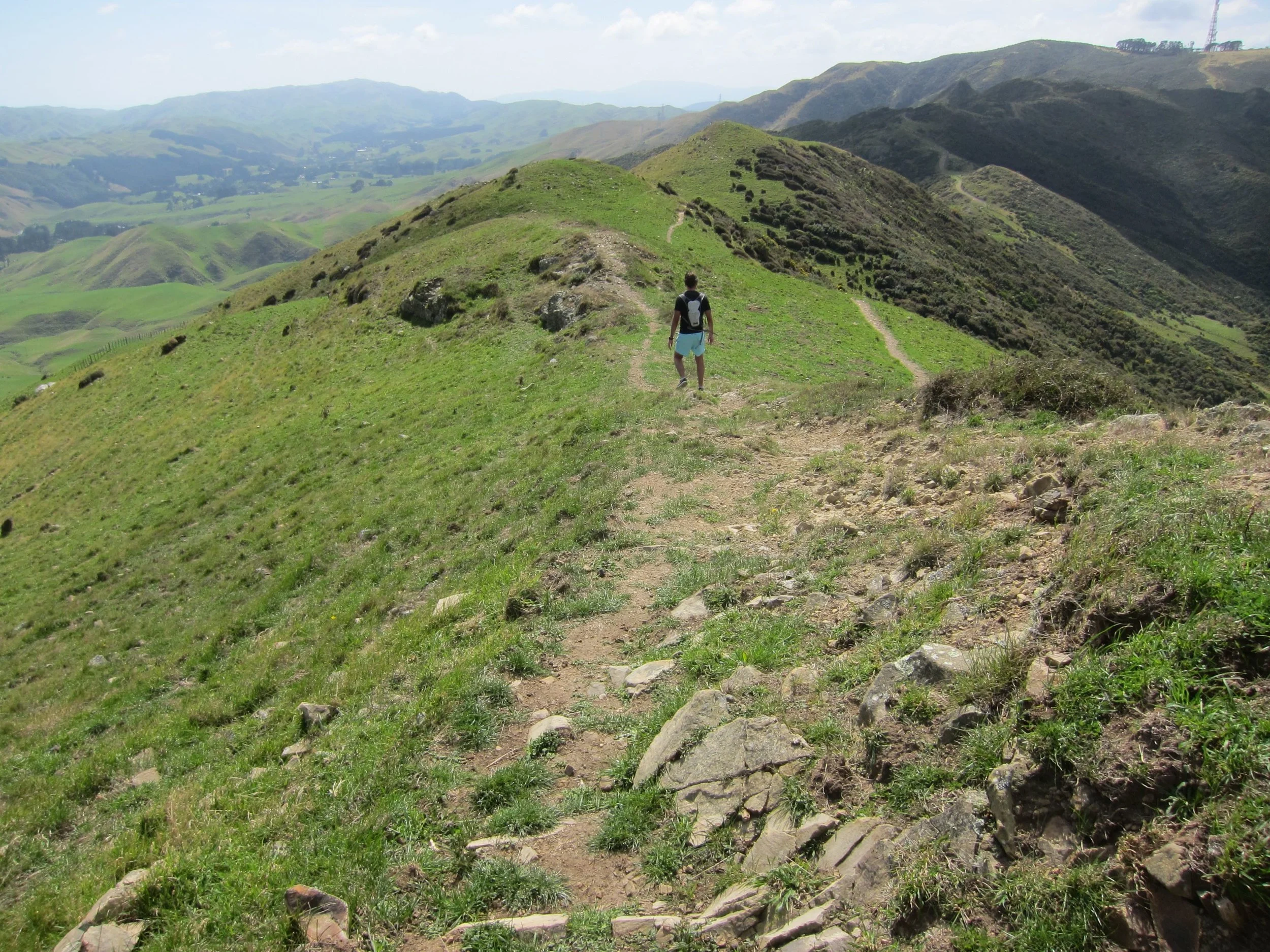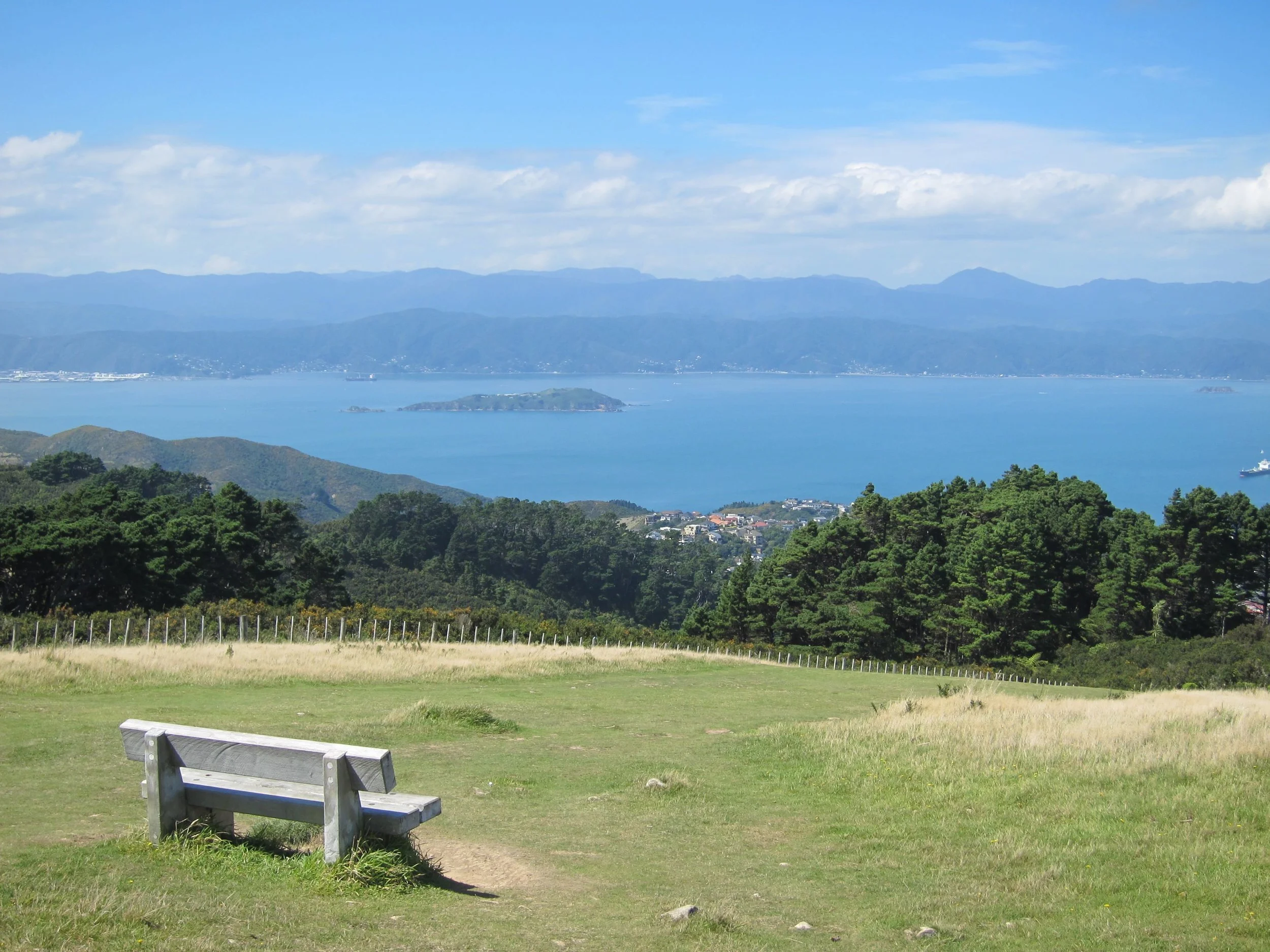Wellington was pretty much burnt to the ground when it was colonised by the Europeans back in the mid 1800s. This isn't to say that all of Wellington was covered in forest, some of the land was cleared by Maori for gardens, but most of Wellington was either swamp or thick impenetrable bush.
There are very few original forest remnants from pre-colonial days, only 1% if you want to be exact. Huntleigh Park Reserve is one of these remnants. It's a small bush-clad hillside that sits between the suburbs of Crofton Downs and Ngaio. Most people are ignorant of its existence (myself included until a year ago).
In early march, a group of friends and I went for a walk. We started at Huntleigh Park and ended up at Mount Kaukau. And why am I telling you this? I'm telling you for a couple of reasons. Firstly I wanted to show you some great pictures of Wellington on a good day, (Wellington is known for its extreme weather) and I wanted to celebrate a few plants, that despite everything (invasion by gorse, pest animals and ignorant humans) are flourishing. It must be said that they're still around because a small army of volunteers protect them in a number of ways: pest control, track improvements, track maintenance and the botanists who fight to keep places like Huntleigh Park safe from development.
This blog is about the unsung heroes of the plant world. The good, the bad, the beautiful and the ugly. Sometimes the bad guys aren't always the bad guys.
Latter on in the blog I want to celebrate the plant heroes in my own suburban garden. It's easy to overlook the plants that you don't have to fuss about, who are dependable and grow like weeds.
46 and 48 Silverstream Road is the inauspicious entrance to Huntleigh Park, Crofton Downs, Wellington.
Our walk began here, at these letterboxes in Silverstream Road. Huntleigh Park has two entrances from Silverstream Road, one to the left of the letterboxes (which we took) and one down the sealed driveway to the right of the letterboxes.
Who'd think that this weed-infested track would take you into an ancient forest.
The long grass and blackberry make way for shrubs and trees. the long black trucks are Cyathea medullaris, Mamaku - tree fern.
One of the very old trees, a Podocarpus totara, I think.
Dodonaea spectabile, Kohekohe.
Huntleigh Park is predominantly a kohekohe forest. There are some very old trees growing here such as totara, hainu, tawa, kahikatea, miro, lancewood and a lone rimu. Opossums love to eat Kohekohe trees, and it's thanks to the poisoning and trapping of these animals that the forest is still standing. Kohekohe trees have a tropical look about them with their sinuous trunks and branches. Their flowers grow straight out of bare trunks and branches, which is unusual. Most trees produces flowers amongst their foliage.
The Tarzan vines or supplejacks are called Ripogonum scandens, Kareao.
Huntleigh Park finishes here.
This is the path that runs between Huntleigh Park and The Crows Nest.
The path that runs between Huntleigh Park and The Crows Nest used to be farmland. A lot of it's covered in gorse. The early European settlers brought gorse to New Zealand to use as hedges. Gorse is so at home in NZ that it flowers twice a year (in Europe it flowers once). Now it's classified as a weed. However, people's perceptions of it have shifted; not everyone is eager to douse it in herbicide. Gorse, believe it or not, has some positive features. In areas that are being reforested with native plants, gorse is being used as a nursery plant. Once the native bushes and trees have grown above the height of the gorse, the gorse dies. Gorse is a legume and like all legumes it adds nitrogen to the soil. Much of Wellington's hillsides are covered in gorse and its roots help stabilise the soil, protecting hills against landslides, which Wellington is susceptible to.
You can see in the photograph above that Brachyglottis (the large leaved plant on the left) and the many Pittosporums (shrubs with small bright green leaves and reddish stems) are out-growing the gorse.
Ozothamnus leptophyllus, Tauhinu.It's flowers are scented.
I had no idea what this shrub was (I couldn't find it in any of my NZ plant books), so I turned to my friend Chris for an answer. He's a botanist. This was his response -
'Tauhinu, Ozothamnus leptophyllus, a native shrub growing to 5 m tall, a member of the Composite (daisy) family. Ecologically, it is an important pioneer woody species which colonises rank pasture, and with other native woody 'grey scrub' species, assists in the reestablishment of native broad-leaved forest removed from the location in the past by farmers. Some farmers dislike it because it colonises rank pasture. The flowers have a honey perfume. Tauhinu may over-top gorse, which can grow to 2 m or more, and shade out the light-demanding gorse.'
Thanks Chris.
Given how hardy tauhinu is I wonder why more of it isn't planted on bare Wellington hillsides.
Wellington Harbour, looking south-east. You can see the Ozothamnus leptophyllus, Tauhinu growing in the foreground.
The Crows Nest Stile.
The hills looking north.
Heading to The Crows Nest, which is the hill on the right.
The Crows Nest, looking West.
The view south from The Crows Nest showing the Makara Wind Farm.
The view of Wellington Harbour from The Crows Nest. The hill range in the distance are the Orongorongos. The small island is Matiu/ Somes Island.
The track linking The Crows Nest with The Skyline Walkway. You can see how easily the gorse colonises this bare hillside.
The Skyline Walkway, looking West. The Ohariu Valley Wind Farm is in the distance.
The Skyline Walkway looking North.
The Skyline Walkway, with the transistor tower on Mount Kaukau in the upper far-right.
A harbour glimpse with the dark smudge in the sea that is Matiu/ Somes Island.
The Skyline Walkway, looking south-east towards the airport.
The wind in Wellington is fierce, it has affected the way these plants grow. Native plants dominate on this hillside. The yellow patches are the gorse flowers.
The Skyline Walkway looking north-west.
This wonderful sheep-like shrub is called Coprosma rhamnoides.
These shrubs remind me of the rocks that moved in that spooky kids book (and TV series in the 60s) Marianne Dreams. Coprosma rhamnoides is a divaricating species. Divaricating means having wide angled branches that are intertangled. New Zealand has more divaricating plants then anywhere else in the world. One theory on why these plants should grow in such an odd way is that they evolved to stop Moas from eating them. Another theory is that these tangled branches and small leaves protect the plant from dry, windy and frosty climates. As you can see from the photos, Coprosma rhamnoides is thriving on these Wellington hillsides.
The Skyline Walkway looking south-east.
Coprosma rhamnoides.
Tussock grass, Carex.
We aren't far from the top of Mount Kaukau, which sits at 445 metres above seas level, trees don't grow this far up. It's grass, Carex and Coprosma country.
The Skyline Walkway, looking south-west.
Wellington Harbour, looking south-east.
Mount Kaukau and the transistor tower.
The Skyline Walkway, looking south. You can see the South Island in the distance - It's barely visible.
Looking back along the Skyline Walkway, where we've just been.
The transistor tower, Mount Kaukau and some hardy pine trees.
The viewing platform, Mount Kaukau.
The view north from the viewing platform, Mount Kaukau.
The view south-east from the viewing platform, Mount Kaukau.
The view south-west from the viewing platform, Mount Kaukau.
The view east, showing Matiu/ Somes Island and the Orongorongo hills.
These 2 shrubs and 1 tree are unsung heroes in my garden because they grow like weeds. It's easy to take these guys for granted. I would argue that their robust nature, ability to grow quickly and luscious foliage make them a must in any garden.
Elingamita arborescens, Whau.
Elingamita arborescens, Whau. A close-up of the seeds.
Whau is a tropical looking tree that needs moist soil and a sheltered position. It can cope with mild frosts. You can propagate it by seed or semi-hardwood or softwood cuttings (I haven't tried this yet). I planted 2 whau in my fernery and stumpless stumpery to provide some much needed shade, quickly. It's a NZ native.
Fatsia japonica.
Fatsia japonica.
The utterly dependable Fatsia japonica is a trooper. It will grow in dry shade, but it grows more vigorously in moist fertile soil. It has exotic looking leaves that marry with any other foliage plant. You can prune it severly and it will still bounce back. It grows quickly and, because of its dense foliage, will hide ugly corners, gas meters and any other unsightly sights in the garden. As its name suggests it is a native of Japan.
Macropiper excelsum, Kawakawa, Pepper Tree. This is a young plant.
Macropiper excelsum, Kawakawa, Pepper Tree.
The kawakawa self seeds all over my garden. It's a NZ native. I must confess, that until I wrote this blog I ignored this plant. Completely ignored it. And yet it has so much going for it. You can make a tea out of its peppery leaves and cook with it. According to one of my plant books it's slow growing, but it isn't in my garden. To be fair my soil is clay and I live in an area where we get a lot of rain and low cloud. The kawkakawa likes damp shady corners. There's a leaf-chewing insect that lives on many of these plants and makes holes in the leaves. The plant is unbothered by this. Apparently, the more holes a leaf has the more peppery it tastes (and the more medicinal it is). The leaves, fruit and bark have medicinal properties. You're supposed to chew the leaves if you have stomach or bladder ailments. And like the whau and the Fatsia japonica the kawakawa has an exotic, tropical look about it...what more could you ask.
Here's a photo of one of my kawakawas looking luscious and leafy along with a shining spleenwort Asplenium oblongifolium and an unknown grass.
In September last year I tried to grow some native clematis, Clematis paniculata, Puawhananga, from seed (blog post 'Survival').
Clematis paniculata, Puawhananga. Growing in Te Kopahou Reserve, Wellington.
It involved a complicated process of soaking the seeds in water, wrapping them in damp tissue paper and putting them in the fridge for a number of weeks. I'm sorry to report that they didn't grow. I don't know what I did wrong. I can't be bothered with hard to grow seeds or plants. I've seen Clematis paniculata growing in the wild, in a harsh windswept spot, and no one can tell me that that plant needed an elaborate process to germinate. Clearly, my seeds were duds.































































